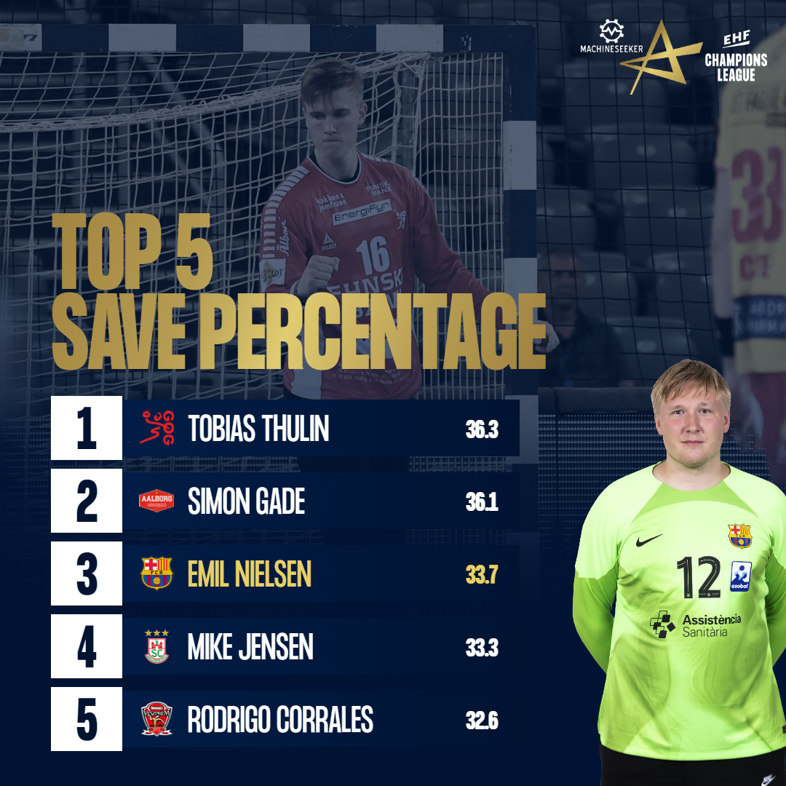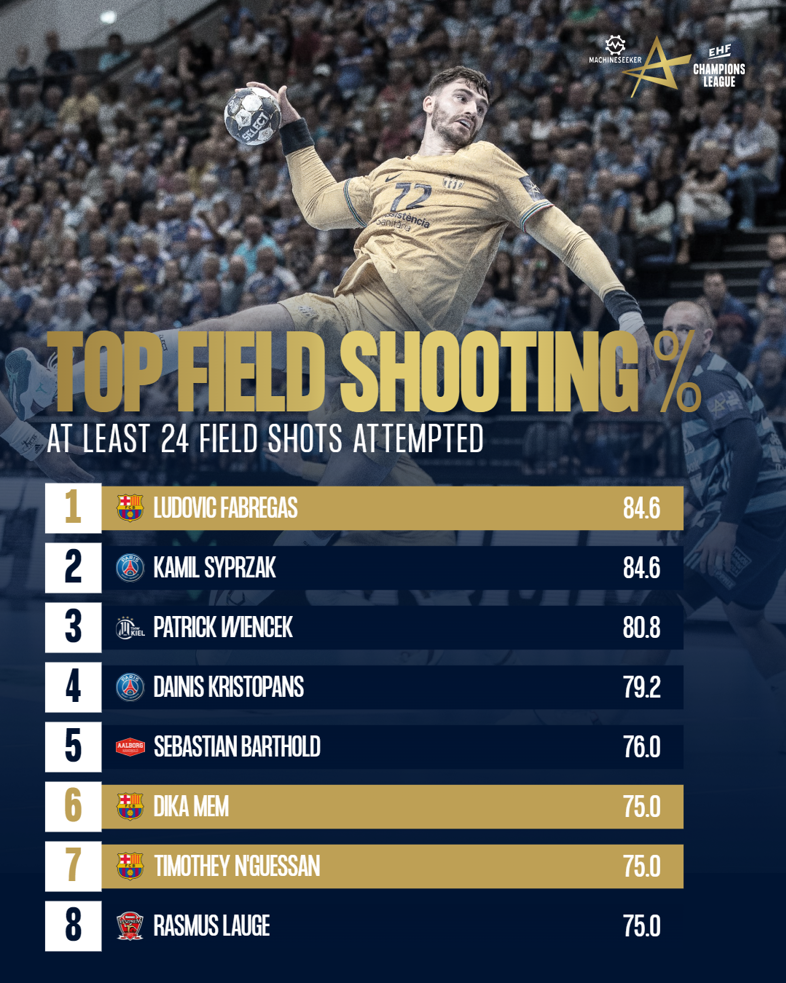Defensively, Barça were already the best team last season. After the group phase, they conceded only 25.3 goals per 50 possessions, after the final they were at 26.2. They allowed their opponents to score only 58.8% of their attempts and force 9.7 turnovers per 50 possessions. In both categories, they lead the way as well.
This season their numbers are even better so far. With only 24.4 goals conceded per 50 possessions, they lead the competition once again. Again, they allow the lowest shooting percentage at 58.3 per cent and force the second-most turnovers with 11.1 per 50 possessions, just 0.1 behind first-placed Paris Saint-Germain.
One of the main reasons for last year’s outstanding defence was goalkeeper Gonzalo Perez de Vargas. He saved 31.4 per cent of the shots on his goal, the second-best value of the whole EHF Champions League. This season he is at just 26.2 per cent so far (12th amongst all goalkeepers that faced at least 40 shots). But this is one of the points where the Catalan club’s new addition comes into play: The young Dane Emil Nielsen is currently in third place with 33.7 per cent of shots on target saved.

Clearly improvement in attack
In offence, however, they had problems after Carlos Ortega took over at the beginning of last season. In the group phase, they scored only 28.3 goals per 50 possessions, which was just tenth best and even slightly below average. But by the later rounds, improvements were visible. After the final they improved to 29.1 (rank 6) but were still 1.9 worse than first-ranked Aalborg Håndbold.
So far in this campaign, their attack numbers have improved considerably. 30.6 goals per 50 possessions is "only" enough for the fourth place. But it is only 1.1 behind Aalborg, who are the best team here as they were last season.
Although Barça allow themselves 8.9 turnovers per 50 possessions (8th), 1.7 more than last season, they make up for this with their shooting percentage. They hit an outstanding 74 per cent of their attempts on goal so far. Only Paris Saint-Germain is slightly better with 76.9%. For Barça, this is an improvement of an impressive 10.8 percentage points.
Barcelona’s outstanding shooting percentage is of course also visible on the player level. They are the only team that has two players in the top ten of field goals scored per game with Dika Mem (6.0) and Ludovic Fabregas (5.5). Even more impressively, Fabregas, Mem and Timothey N’guessan all are in the top eight at field shooting percentage amongst the 33 players that took at least 24 shots from the field.

Fabregas’ numbers are especially impressive. Even though he takes 2.5 shots per game more than last season, his shooting percentage has improved by 17.9 percentage points. For Mem the number of goals scored has slightly improved even though he took 1.6 shots less so far because he scored on 16.1 per cent more of his attempts. N’guessan has improved his output as well as he has the same number of shots but a shooting efficiency that improved by 24.4 per cent. Especially for backcourt players such as Mem and N’guessan, these numbers are impressive.
Counterattack is the key
It is also noticeable that Barça are pushing the pace even more than last season. In 2021/22 they already had the fourth most possessions per game (54.2) and third shortest offensive possessions on average (31.6 seconds).
While the new rules with the new throw-off area and fewer passes allowed after the warning for passive play have led to more possessions overall and thus shorter possessions on average, Barça’s numbers exceed the average change clearly.
On average there are 2.6 possessions more and 1.6 seconds shorter possessions. In contrast, Barça’s possessions have increased by even 5.5 to 59.8 while the average possession time has decreased by 4.1 seconds compared to last season.
Hence, Carlos Ortega's team relies even more on the tempo game this season, which is based on their strong defence and lead to their greatly improved shooting percentage. In the Spanish league, where they are rarely challenged by their opponents and have so far won their games with an average of 10.4 goals difference, they already implemented this style of play mercilessly.
The 46:30 victory in Elverum, which according to Rasmus Boysen was the second-most goals scored by Barcelona in the history of the EHF Champions League, also came about in the same way. In 62 possessions they had an average of 23.9 seconds per offensive possession and scored on an outstanding 90.2 per cent of their throws. According to Sergio Palazzi, who analysed this game more in-depth in his newsletter, the share of counterattack possessions was 52 per cent.
Of course, there are only four games played so far and Barça’s schedule has been relatively easy. In fact, together with Aalborg, Nantes, and Kiel they had the easiest schedule so far, as their opponents on average have just won 0.5 points per game so far.
Last season, after a decent start to the season, there was a small dip in performance towards the middle of the group stage. At that time, however, their start to the season was nowhere near as good as it has been this season. The additions of Emil Nielsen, Jonathan Carlsbogard and Hampus Wanne, as well as the familiarity with coach Carlos Ortega, seem to have made the double-defending champions even stronger. They are definitely the favourites once again.
The only good thing for the 15 other teams is that by the time we reach the TruckScout24 EHF FINAL4 they only need to be defeated once. And even though handball is a game with relatively little chance due to the many possessions, one single victory is always possible.
Julian Rux is a data analyst and data journalist. More of his work can be found on his website and blog Handballytics.de as well as on social media: Instagram, Facebook and Twitter.









